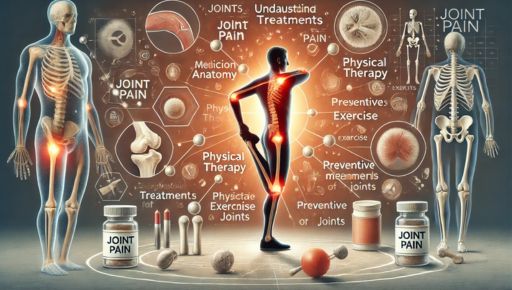Health
Effective Solutions for Joint Pain: Understanding Causes, Treatments, and Prevention

Joint pain is a widespread issue affecting people of all ages and backgrounds. Whether it’s a mild discomfort or chronic pain, joint pain can significantly impact daily activities and overall quality of life. Fortunately, there are numerous treatments available to help manage joint pain, as well as preventive measures to minimize its occurrence. In this article, we’ll explore the causes of joint pain, common treatment options, and tips for prevention.
What is Joint Pain?
Joint pain, also known as arthralgia, refers to discomfort, soreness, or aching in any of the body’s joints. Joints are the areas where two or more bones meet, allowing for movement and flexibility. They include the knees, elbows, shoulders, hips, and spine. When these joints become inflamed, injured, or worn down, joint pain can occur.
Common Causes of Joint Pain
Joint pain can result from a variety of factors, from injuries to chronic conditions. Here are some of the most common causes:
1. Osteoarthritis
Osteoarthritis (OA) is the most common type of arthritis and a major cause of joint pain. It occurs when the cartilage, which cushions the joints, begins to wear down over time. This leads to friction between the bones, causing pain, swelling, and stiffness. OA commonly affects the knees, hips, and hands.
2. Rheumatoid Arthritis
Rheumatoid arthritis (RA) is an autoimmune condition where the body’s immune system mistakenly attacks the lining of the joints. This results in inflammation, pain, and eventually, joint damage. RA often affects joints on both sides of the body and can cause long-term disability if left untreated.
3. Gout
Gout is a type of arthritis caused by an excess of uric acid in the blood. This acid forms crystals that accumulate in the joints, most commonly affecting the big toe. Gout attacks can be sudden and severe, causing intense pain and swelling in the affected joint.
4. Joint Injuries
Injuries such as sprains, strains, fractures, or dislocations can cause joint pain. These injuries can lead to inflammation, swelling, and bruising around the affected joint, making movement difficult. Joint pain caused by injury is often acute but can become chronic if not properly treated.
5. Bursitis and Tendonitis
Bursitis and tendonitis are conditions caused by inflammation of the bursa or tendons. Bursitis is the inflammation of small fluid-filled sacs (bursae) that cushion the joints, while tendonitis occurs when tendons, which connect muscles to bones, become irritated. Both conditions can lead to joint pain and stiffness.
Symptoms of Joint Pain
Joint pain symptoms can vary depending on the underlying cause. Common signs to watch for include:
- Pain and tenderness around the affected joint
- Swelling or warmth at the joint
- Stiffness and limited range of motion
- Redness or bruising near the joint
- Popping or crunching sounds (crepitus) when moving the joint
If you experience persistent joint pain or if it’s accompanied by severe swelling, redness, or fever, it’s important to consult a healthcare professional for a proper diagnosis and treatment plan.
Treatment Options for Joint Pain
Managing joint pain often involves a combination of therapies, lifestyle changes, and medications. Here are some of the most effective treatment options:
1. Medications for Joint Pain Relief
- Over-the-counter pain relievers: Nonsteroidal anti-inflammatory drugs (NSAIDs) such as ibuprofen and naproxen can reduce pain and inflammation in the joints.
- Acetaminophen: This medication can provide relief from mild joint pain, though it doesn’t reduce inflammation.
- Topical creams: Creams containing menthol or capsaicin may provide temporary pain relief when applied to the skin over the affected joint.
- Corticosteroid injections: These injections deliver strong anti-inflammatory medication directly into the joint, providing relief for conditions like arthritis or bursitis.
- Disease-modifying antirheumatic drugs (DMARDs): These medications are used to treat autoimmune conditions like rheumatoid arthritis, helping to slow down the progression of joint damage.
2. Physical Therapy and Exercise
Regular exercise and physical therapy can strengthen the muscles around the joint, improving mobility and reducing pain. Low-impact activities such as swimming, cycling, or walking are ideal for individuals with joint pain, as they put less stress on the joints. Physical therapy can also include stretching, joint mobilization, and strengthening exercises to restore function and alleviate discomfort.
3. Surgical Interventions
In severe cases of joint pain caused by conditions such as osteoarthritis or rheumatoid arthritis, surgery may be necessary. Some common surgical options include:
- Arthroscopy: A minimally invasive procedure where a small camera is inserted into the joint to repair damage or remove debris.
- Joint replacement: In cases of advanced joint damage, a full or partial joint replacement (such as a knee or hip replacement) may be recommended to relieve pain and restore function.
- Fusion surgery: This procedure involves fusing bones together in cases where other treatments are ineffective.
4. Lifestyle Modifications
Making certain lifestyle changes can help manage joint pain and reduce the risk of further damage:
- Weight management: Carrying excess weight puts added stress on weight-bearing joints, such as the knees and hips. Maintaining a healthy weight can reduce the burden on your joints and alleviate pain.
- Proper posture: Maintaining good posture while sitting, standing, and walking helps distribute weight evenly across the joints and reduces strain.
- Joint protection techniques: Using assistive devices like braces, splints, or orthotic shoes can help support joints and prevent further injury.
5. Natural Remedies and Supplements
Some people find relief from joint pain through natural remedies and supplements. While scientific evidence on their effectiveness varies, the following may help:
- Turmeric: The active compound curcumin in turmeric has anti-inflammatory properties that may reduce joint pain and stiffness.
- Fish oil: Omega-3 fatty acids found in fish oil may help reduce joint inflammation and improve mobility.
- Glucosamine and chondroitin: These supplements are believed to support cartilage health and reduce the symptoms of osteoarthritis.
Preventing Joint Pain: Tips for a Healthier Future
While some causes of joint pain are unavoidable, there are several steps you can take to prevent or reduce the risk of developing joint pain:
- Stay active: Regular exercise strengthens muscles and improves joint flexibility.
- Use proper techniques: When lifting or engaging in physical activities, use proper posture and techniques to avoid straining your joints.
- Warm up before exercise: Stretching and warming up before physical activity helps prepare your joints and muscles for movement, reducing the risk of injury.
- Eat a balanced diet: A healthy diet rich in anti-inflammatory foods (such as fruits, vegetables, and whole grains) can support joint health.
- Stay hydrated: Drinking plenty of water helps keep the joints lubricated and functioning properly.
Conclusion
Joint pain is a common issue that can range from mild discomfort to severe, chronic pain. Understanding the underlying causes, exploring treatment options, and making preventive lifestyle changes can help manage joint pain effectively. If joint pain persists or worsens, it’s important to seek professional medical advice to identify the best course of action for your condition. By taking proactive steps and embracing a healthy lifestyle, you can significantly improve your joint health and quality of life.
Health
Discover the Best Urology Hospital in Bangalore for Expert Care and Compassionate Treatment
When it comes to urological health, early diagnosis and specialised treatment make a world of difference. Bangalore, often hailed as the healthcare capital of India, offers a range of advanced medical facilities. Among these, some hospitals stand out for their state-of-the-art equipment, highly experienced doctors, and a patient-first approach. If you’re searching for a urology hospital in bangalore, that blends technology with compassion, you’re in the right place.
Why Choose a Urology Hospital in Bangalore?
Bangalore is home to several multispeciality hospitals and specialised urology centres that offer comprehensive services ranging from minor consultations to complex surgeries. These hospitals cater to a variety of urological conditions including:
- Kidney stones
- Urinary tract infections (UTIs)
- Prostate enlargement
- Male infertility
- Incontinence
- Bladder cancer
- Erectile dysfunction
Most top hospitals in Bangalore use minimally invasive techniques such as laparoscopy and laser treatment, ensuring faster recovery and minimal discomfort.
Cutting-Edge Technology Meets Patient-Centred Care
What sets apart the best urology hospitals in Bangalore is not just the availability of advanced medical technology, but the integration of that technology with patient-focused care. From 3D laparoscopic surgeries to robotic-assisted procedures, these hospitals are redefining how urological treatments are delivered in India.
Moreover, many of these hospitals are NABH-accredited, which ensures strict adherence to quality standards in treatment and hygiene. International patients often prefer Bangalore due to world-class infrastructure at a fraction of the cost compared to Western countries.
What to Expect from the Best Urology Hospital in Bangalore
Finding the best urology hospital in bangalore involves more than just looking at the number of surgeries performed. Here’s what you should expect:
- Specialised Urologists: Doctors with decades of experience and super-specialisation in areas like andrology, uro-oncology, paediatric urology, and reconstructive urology.
- Comprehensive Diagnosis: High-end diagnostic tools like uroflowmetry, urodynamic studies, CT urography, and digital cystoscopy.
- Tailored Treatments: Each patient is given a customised treatment plan. This ensures not just successful outcomes, but also minimal side effects.
- Privacy & Comfort: Urological problems can be sensitive. The best hospitals in Bangalore offer private consultation rooms and a discreet treatment environment.
- Post-Surgery Support: From diet plans to physiotherapy and regular follow-ups, recovery support is an essential part of the process.
Popular Urology Procedures Offered in Bangalore
Some of the most commonly performed urological procedures in Bangalore include:
- TURP (Transurethral Resection of the Prostate)
- PCNL (Percutaneous Nephrolithotomy)
- Ureteroscopy
- Lithotripsy
- Circumcision
- Vasectomy and reversal
- Bladder augmentation
- Robotic radical prostatectomy
Most procedures are performed using advanced tools and techniques, ensuring quicker recovery times and minimal hospital stay.
Choosing the Right Hospital: What Patients Say
Patient testimonials often point to a few hospitals as being the most trustworthy in terms of care, affordability, and outcome. Many families express gratitude for the detailed counselling, clear communication, and round-the-clock support they received. Some hospitals also offer online consultations and second opinions for those living outside Bangalore or abroad.
Final Thoughts
Your urological health deserves the best attention and expertise. Bangalore offers a perfect blend of modern medical technology, compassionate care, and affordability. Whether it’s a routine check-up or a complex surgery, choosing a reputed hospital ensures you’re in safe hands.
Health
Top-Rated Heart Hospital in Hyderabad: Your Guide to the Best Cardiology Care
Hyderabad, a bustling hub of healthcare innovation, has earned its place as a destination for world-class heart treatment. From advanced cardiac procedures to compassionate patient care, the city is home to some of the most renowned hospitals in India. Whether you’re seeking routine cardiology consultations or complex heart surgeries, Hyderabad’s heart hospitals offer a perfect blend of modern technology and experienced specialists.
In this article, we explore what makes the city a leading heart care destination and help you discover the Heart Hospital in Hyderabad for your needs.
Why Choose a Heart Hospital in Hyderabad?
Hyderabad has grown to become one of India’s top healthcare destinations, especially for cardiac care. Here’s why:
- World-Class Infrastructure: Heart hospitals in Hyderabad are equipped with cutting-edge technology like robotic surgery systems, advanced cath labs, 3D imaging, and hybrid operating rooms.
- Highly Skilled Cardiologists: Many cardiologists and cardiac surgeons practicing in Hyderabad are globally trained and have decades of experience treating critical heart conditions.
- Affordable Yet Quality Care: Compared to Western countries, and even some Indian metros, Hyderabad offers cost-effective cardiac treatments without compromising on quality.
- Global Patient Footfall: Patients from across the globe — especially from Africa, the Middle East, and neighboring South Asian countries — visit Hyderabad for heart treatment, thanks to its high success rates and warm hospitality.
Services Offered by Top Heart Hospitals
The leading best cardiology hospital in hyderabad will typically provide a wide spectrum of services under one roof. These include:
- Preventive Cardiology: Early detection and lifestyle counseling to manage risk factors like hypertension, cholesterol, and diabetes.
- Interventional Cardiology: Non-surgical treatments such as angioplasty, stenting, and catheter-based procedures.
- Cardiac Surgery: Bypass surgeries (CABG), valve replacements, congenital heart defect repairs, and minimally invasive heart surgeries.
- Electrophysiology: Treatment for rhythm disorders, pacemaker or ICD implantation, and ablation procedures.
- Rehabilitation & Follow-up Care: Cardiac rehab programs for recovery, lifestyle change, and long-term heart health.
These hospitals are also equipped to handle cardiac emergencies 24/7, with rapid response units and ICU care.
How to Choose the Right Hospital?
Choosing the right hospital can be a life-changing decision. Keep these factors in mind:
- Experience and Reputation: Check for hospitals with a track record of high success rates and experienced cardiac teams.
- Technology and Facilities: Look for NABH/JCI accreditation, modern operation theatres, and advanced diagnostic labs.
- Patient Testimonials: Real-life stories often reflect the hospital’s commitment to care and successful recovery journeys.
- Location and Accessibility: Choose a hospital that’s easily reachable in case of emergencies.
- Cost and Insurance Support: Transparent pricing and insurance partnerships make treatment smoother.
Notable Heart Hospitals in Hyderabad
Here are some of the reputed names in the field of cardiology in Hyderabad:
- Apollo Hospitals, Jubilee Hills: Known for its pioneering work in cardiac care, including robotic surgeries and heart transplants.
- CARE Hospitals, Banjara Hills: Offers comprehensive cardiac treatments and is known for high success rates in angioplasty and bypass surgeries.
- Yashoda Hospitals: Equipped with advanced diagnostic and surgical facilities, and experienced in both pediatric and adult cardiology.
- KIMS Hospitals, Secunderabad: A preferred center for heart patients looking for affordable, high-end cardiac procedures.
Each of these hospitals is supported by world-class infrastructure, round-the-clock care, and experienced cardiologists, making them top choices for heart treatment in the city.
Final Thoughts
If you or your loved ones are dealing with a heart-related condition, you’re in safe hands in Hyderabad. The city continues to lead the way in cardiac healthcare, combining compassion, innovation, and excellence.
Health
Managing Nerve Pain: Diagnosis and Treatments

What is nerve pain?
Nerve pain can be one of the most uncomfortable and frustrating health issues to deal with. The sensation is often described as burning, stabbing, shooting or a combination of all three. The pain may be chronic, or come and go. This pain occurs as a result of damage or irritation to the nerves of your body and can arise from injuries, medical conditions such as diabetes, infections, and even in some cases following surgery.
Getting the right diagnosis
The next step for most anyone suffering with nerve pain are the next steps to getting properly diagnosed. Many people suffer with pain for years without ever knowing the cause. The way doctors look for the cause of nerve pain is to first perform a physical examination and then start with a discussion about the pain. They are usually interested in when it started, what makes it better or worse, and whether you have other medical problems. They usually do blood work, nerve studies, and/or scans like CAT or MRI to help find the cause of your pain.
Pain management specialist
If they identify a cause they will begin to help you to put together a plan of treatment. And this is when a pain management specialist can really help you. Pain management doctors help to reduce pain and improve quality of life through medical treatment. They use both medicine and patient-centered approaches like behavioral social and emotional support, in decisions related to care. They will work to find the most efficacious treatment options for you.
Treatment Approaches for Nerve Pain
Treatment options for nerve pain may include medication. Some medications decrease nerve sensitivity, while others decrease swelling or muscle spasms. Physical therapy is commonly prescribed to increase strength and flexibility, and lessen pain as time goes on.
For some patients, advanced treatment options with injections, nerve blocks, or electrical nerve stimulation can provide great pain relief. These treatments directly target the affected nerve areas where the pain signals originate, and calm them down. If the pain is due to nerve compression/damage that can be repaired, then surgery may be considered.
Lifestyle Changes That Support Relief
Lifestyle changes also help manage neck pain. Some lifestyle changes that can be helpful include regular gentle exercise, good diet, and good sleep habits. Decreasing stress with activities such as meditation, yoga, or listening to music can be beneficial as stress will generally intensify the pain experience.
Acting early
It’s important to keep in mind that nerve pain will not (may not) go away entirely, but, if it is taken care of appropriately, it can be managed effectively. Early assessment and a customized treatment plan can provide the ability to prevent the pain from worsening and continue on with your daily activities.
If you experience ongoing pain, which does not go away, you should get advice for an assessment. You should not ignore the symptoms or wait too long before getting help to manage them. The earlier you act, the better your chance of finding relief and preserving your nerve health.
